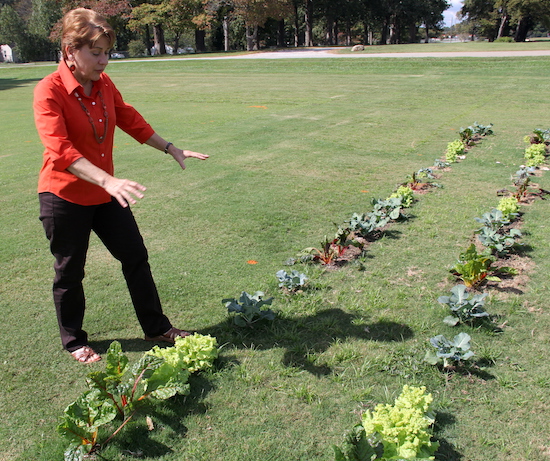A team of University of Georgia researchers is studying the use of home lawns as garden plots. If successful, suburbanites with warm-season lawns could plant fall vegetables on top of their turfgrass lawns.
“Enthusiasm for local food production and self-sufficiency has generated an increased interest in home vegetable gardens. But, many urban dwellers have small outdoor spaces and often lawns occupy the only full sun areas in the landscape,” said Ellen Bauske, a program coordinator at the Georgia Center for Urban Agriculture and leader of the project.
A happy medium
Many would-be urban gardeners love their lawns too much to replace them with a vegetable garden, according to Bauske.
“They enjoy spending their summers on the lawn, watching the kids play while admiring their well-manicured lawn,” she said. “Tearing up the lawn and putting in a traditional garden may not be the best option. Gardens are a lot more work to maintain than lawns and have an unconventional look. Your neighbors may not be pleased to see a working garden in your front lawn.”
At UGA, Bauske’s goal is to find a happy medium—a way to successfully grow vegetables without destroying turfgrass. She, along with horticulturist Sheri Dorn and turfgrass specialist Clint Waltz, all with the UGA College of Agricultural and Environmental Sciences, are recording the effects of planting fall vegetable crops into warm-season hybrid bermudagrass.
“If you have a warm-season grass, it will be dormant in the fall and winter, so you are essentially double cropping (planting one crop after another crop),” she said. “This research is targeted to homeowners with small yards who want to dip their toe into the fast-moving stream of the local food movement.”
Four methods being tested
The first season of the research trial began in September when the UGA researchers planted lettuce, broccoli and Swiss chard into a bermudagrass research plot.
The team planted vegetables four ways: directly into the turfgrass, directly into the turfgrass after spraying Roundup, into strips made with a small rototiller and into rototilled strips where the turfgrass was first sprayed with Roundup.
“It looks like we are going to have a viable crop of winter vegetables from each treatment, though you can see the effect of competition with the grass in some of the treatments,” Bauske said. “Growing the vegetables is the first part of the study. The second half we'll be watching to see how the turfgrass recovers and performs in the spring and summer.”
The test will be repeated next winter before the research findings are published.
Can you make it pretty, too?
Bauske said the next logical step in the research would be making the turfgrass/winter garden physically attractive from the roadside.
“We planted a variety of Swiss chard called Bright Lights. It’s beautiful and has different colored stems. It’s quite striking!” she said.
That is not the only attractive vegetable. Italian broccoli and many lettuces also offer optical interest and variety. Dwarf broccoli, she said, would also make the garden more attractive. “This way, you can eat your homegrown vegetables and enjoy the view.”
For home gardeners who can tolerate a few weeds in their lawn, Bauske said many commonly found weeds can be eaten. These include wild garlic, white clover, dandelions, yarrow, cat’s ear, plantains and coltsfoot.
Waltz says the study shows promise, but he’s not ready to encourage homeowners to plant gardens in their front lawn yet.
“We’ve learned a few things by doing a pilot study last year before planting this year’s replicated trial,” he said. “There's promise, but we still have a lot to learn about how to optimize vegetable production and return the turf to a safe lawn for play and enjoyment.”








